When exploring traditional Korean noodle soup varieties, you'll discover a rich culinary landscape that extends far beyond the popular spicy Korean noodle soup options many Westerners recognize. Korean noodle soups represent one of the country's most beloved comfort foods, with each region developing its own distinctive style based on local ingredients and historical influences.
Essential Korean Noodle Soup Varieties
Understanding the diversity of Korean noodle soups requires examining their fundamental categories. Unlike Japanese or Chinese noodle traditions, Korean varieties often feature unique combinations of ingredients and preparation techniques that reflect Korea's agricultural history and seasonal climate patterns.
| Noodle Soup | Key Ingredients | Seasonality | Regional Origin |
|---|---|---|---|
| Naengmyeon | Buckwheat noodles, beef broth, dongchimi, pear, cucumber | Summer | North Korea (Pyongyang style) |
| Jajangmyeon | Wheat noodles, chunjang (black bean paste), pork, vegetables | Year-round | Shandong, China (Korean adaptation) |
| Budae Jjigae | Various noodles, spam, hot dogs, kimchi, ramen | Winter | Uijeongbu |
| Rabokki | Ramen noodles, tteokbokki, gochujang, fish cakes | Year-round | National street food |
Cultural Significance of Korean Noodle Soups
Korean noodle soup cultural significance extends beyond mere sustenance—it represents historical adaptation and national identity. During Korea's Japanese occupation (1910-1945), noodle dishes became symbols of resistance and cultural preservation. The famous Jajangmyeon, originally a Chinese dish, was transformed by Korean chefs using locally available ingredients, creating what's now considered a Korean comfort food staple.
Traditional Korean noodle soup preparation often involves multiple-day processes for authentic flavors. For instance, proper Naengmyeon broth requires simmering beef brisket and radish water kimchi (dongchimi) for 8-12 hours. This dedication to preparation reflects the Korean culinary philosophy of jeong—the emotional investment in food preparation that conveys care to the recipient.
Regional Variations Across Korea
Regional Korean noodle soup differences reveal fascinating culinary adaptations. In Busan, you'll find Milmyeon, a cold noodle soup with a distinctive red broth made from chili powder and anchovy broth, reflecting the coastal city's fishing culture. Meanwhile, Andong Soesamgye Jjimdak features wheat noodles with braised chicken in a soy-based sauce, showcasing the inland city's agricultural traditions.
Understanding these regional distinctions helps appreciate how Korean noodle soups evolved differently based on local resources. Northern varieties tend to feature heartier broths suited to colder climates, while southern versions often incorporate seafood elements reflecting coastal availability. This regional diversity makes exploring authentic Korean noodle soup recipes a journey through Korea's geographical and cultural landscape.
Modern Interpretations and Health Benefits
Contemporary Korean noodle soup preparation balances tradition with modern nutritional understanding. Traditional broths made from beef bones or anchovies provide natural collagen and amino acids, while vegetable additions like Korean radish and scallions contribute vitamins and digestive enzymes. Many traditional Korean noodle soups offer surprising health benefits when prepared authentically.
For those interested in how to make Korean noodle soup at home, the key lies in balancing the five fundamental Korean flavors: sweet, salty, sour, bitter, and umami. Authentic recipes rarely rely on shortcuts—properly made broth forms the foundation, while garnishes like toasted sesame seeds or perilla leaves add finishing complexity. Modern adaptations sometimes incorporate Western ingredients while maintaining the essential flavor profile that defines each variety.
Common Misconceptions About Korean Noodle Soups
Many people mistakenly believe all Korean noodle soups are extremely spicy, but this represents only a portion of the tradition. In fact, Pyongyang-style Naengmyeon features a clear, tangy broth with minimal heat, while Jajangmyeon offers a savory-sweet profile without spiciness. Understanding these distinctions helps appreciate the full spectrum of traditional Korean noodle soup varieties.
Another misconception is that Korean noodle soups are quick meals. While instant versions exist today, authentic preparation often requires significant time investment—broths simmer for hours, and ingredients are carefully selected based on seasonal availability. This dedication to process explains why properly made Korean noodle soups deliver such complex, satisfying flavors that have sustained their popularity for generations.
What's the difference between Korean and Japanese noodle soups?
Korean noodle soups typically feature bolder, more assertive flavors with prominent use of garlic, sesame oil, and fermented ingredients like gochujang. Japanese noodle soups emphasize delicate dashi broths with subtle umami. Korean varieties often incorporate more vegetables and meat, while Japanese versions focus on precise broth preparation and noodle texture.
Can I make authentic Korean noodle soup without specialty ingredients?
Yes, you can create satisfying Korean noodle soup with substitutions. For gochujang, combine tomato paste, red pepper flakes, and a touch of sugar. Use regular wheat noodles if Korean varieties aren't available. The key is balancing sweet, salty, and spicy elements. While not identical to traditional Korean noodle soup recipes, these adaptations maintain the essential flavor profile.
What's the proper way to eat Korean cold noodle soup?
For authentic Korean cold noodle soup like Naengmyeon, mix the broth and noodles thoroughly before eating. Koreans traditionally cut the long noodles with scissors before serving to make them easier to eat. The proper sequence is to first enjoy the noodles with broth, then add vinegar and mustard to taste, and finally drink the remaining broth after finishing the noodles.
Are Korean noodle soups typically gluten-free?
Most traditional Korean noodle soups contain gluten, as wheat-based noodles are common. However, Naengmyeon uses buckwheat noodles which are naturally gluten-free (though often mixed with wheat flour). For authentic gluten-free Korean noodle soup options, look for dishes made with sweet potato starch noodles like those in Japchae, or verify that Naengmyeon uses 100% buckwheat noodles.











 浙公网安备
33010002000092号
浙公网安备
33010002000092号 浙B2-20120091-4
浙B2-20120091-4